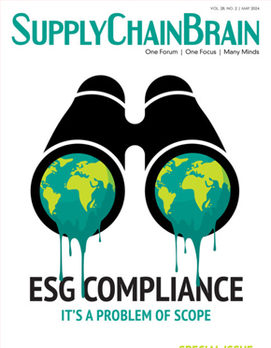
COVID-19 and pandemic restrictions changed how our society purchases and transports consumer goods.
Before the pandemic, shopping online was steadily growing. The pandemic restrictions caused individuals who never shopped on their mobile phones and computers to set up digital shopping carts at their favorite online stores. For example, Target’s online sales jumped 141% from the previous year, and in the month of April, 2020, Target’s average day sales surpassed the prior year’s Cyber Monday sales. The trend continued through the 2020 holiday season, as record numbers of people shopped exclusively online, despite deep-rooted traditions of sharing in the holiday bustle at shopping centers and malls.
Consumers were forced to overcome the barriers that formerly slowed their use of online markets, and as a result discovered the convenience and benefits of e-commerce shopping. Consequently, many have fully embraced online shopping, and it may have forever change how they shop. This change increases delivery demand and requires a strong focus on residential deliveries (or final mile delivery), vastly altering the transportation landscape.
Although we’re still in the midst of the pandemic, up to this point the surge in e-commerce business has caused retailers merely to keep up with demand. But now, over a year into the constant peak, it’s time to adjust business models to sustain a heightened e-commerce market.
To this end, companies are evaluating how to more effectively and efficiently get their products to consumers. This is a difficult challenge in a transportation environment already burdened with limited capacity, weakened bargaining power, increased risk shifting to the shipper, higher amounts of cargo loss and damage, and increased returns — all at an increased cost. In the face of the increasing demand, providers also struggle with how to boost their efficiency, despite limited resources of equipment and personnel.
Together, shippers and providers search for ways to limit their risks and loss in a difficult market. While the following options aren’t new, they should be reconsidered to eliminate and reduce potential risk in the present e-commerce transportation market.
Start with a negotiated contract. Negotiated contracts have traditionally been the best way for shippers and providers to manage risks with transportation, as they address the standard of services, liability, insurance, and indemnification obligations. While the use of negotiated contracts is a standard part of operations, the pandemic has greatly changed the discussions on rates, capacity, standardization, equipment, return processes, and decreased ramifications for service failures. Opportunities to renegotiate terms in light of the changing landscape presented by the pandemic should therefore be considered.
Carry adequate insurance. Insurance remains an important tool for addressing risk. As in the past, to succeed in today’s transportation environment, supply chain risk should be evaluated and managed from purchase through delivery. To the extent that shippers assumes the risk of their cargo, it’s critical that they carry adequate insurance. Transportation providers, depending on their scope of operations, are required to assume some risk for loss or damage to cargo arising from their negligence, and must carry a minimum level of insurance. In addition to the traditional lines of insurance for transportation services, due to the increase in online orders and home delivery, cyber insurance has begun to surface to address any improper handling or sharing of consumers’ personal information.
Revaluate your packaging. Packaging is a key element that can affect safe delivery of freight. To a greater degree than in the past, the responsibility for proper packaging for transportation is being shifted to the shipper. Care in securing new cartons that better fit the size of the contents, and filling empty space within the carton with packaging protection, has been found to markedly prevent damage during transportation. Shippers should therefore reevaluate their packaging and update as needed to better insulate themselves from risk exposure.
Prevent unnecessary risk when it comes to personal information. Protection is required whenever any type of personal information about the consumer is disclosed, shared, processed, or used. Processes that limit the amount and type of disclosure to only the information necessary for the transportation service will prevent unnecessary risk. Once so disclosed, data-security efforts to prevent disclosure or unnecessary retention of such information would be beneficial. Given the ever-evolving e-commerce world, an updated risk evaluation of customer data protection processes is recommended.
Implement a consumer-friendly return process. Loss, damage, and returns remain key considerations, as all have vastly increased with the boom in e-commerce deliveries. The sheer volume of final-mile transportation requirements has led to more retailer mistakes, parcels being damaged with handling, misdeliveries, and package theft. These issues are compounded by the removal of signed deliveries upon dropoff, in an effort to provide “contactless” deliveries. Because online sales are returned with 30% more frequency, a consumer-friendly returns process — arranged in advance between shipper and provider — is important for a positive customer experience.
Returns, or reverse last-mile logistics, are critical to the success of an online business, but the process is complicated and costly. So much so that at various times some retailers have told the consumer to simply throw away the item to be returned, and issued a “returnless refund.” It‘s estimated that 65% of all returns are the result of the retailer’s mistake because the product was damaged at the onset, or the wrong item was sent to the customer. Greater care to inspect and package goods at the onset can reduce the losses that are experienced with returns. Policies and procedures should be implemented with a focus on this early stage of the delivery process.
As COVID-19 restrictions lift, there’s no indication that the e-commerce peak will subside greatly, due to persistent consumer fears about the virus. Shoppers might also continue to take advantage of the convenience of online ordering and home delivery, rather than return to in-store shopping. As we continue into year two of the pandemic, and retailers evolve in line with changing customer habits, the above-addressed options should be considered. Flexible companies will be able to embrace the changing shopping landscape, and attempts by shippers and providers to adapt to the continued e-commerce peak with techniques that address transportation risk will lead to greater efficiency and sustainability.
Angela Alexander Savino is an atttorney at Perez Morris LLC.


.jpg?height=100&t=1715228265&width=150)
.jpg?height=100&t=1715141311&width=150)


